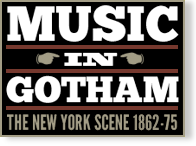Thomas Central Park Garden Concert: 4th
Event Information
Venue(s):
Central Park Garden
Proprietor / Lessee:
John Koch
Conductor(s):
Theodore Thomas [see also Thomas Orchestra]
Price: $.50; $1 & $2 extra, private boxes
Event Type:
Orchestral
Record Information
Status:
Published
Last Updated:
24 June 2025
Performance Date(s) and Time(s)
20 May 1875, 8:00 PMPerformers and/or Works Performed
Citations
“Mr. Thomas’ Summer night concerts at the Central Park Garden have now fairly commenced. They have of course been largely attended—so largely, indeed, that it is difficult to divine where room will be found for all the frequenters of these delightful entertainments when the hot weather finally sets in. The concerts are quite as deserving of encouragement as ever. Larger bands than Mr. Thomas’ are plenty abroad, but in none of the European capitals is there to be found an orchestra superior in point of individual talent and discipline, and none can boast an organization whose repertoire is of so high an order, so varied and so rich. The programme could easily be changed every evening, and we dare say that, for six months, no novelty would have to be [illegible] for performance. That new works will, however, be made known during the regular Summer campaign may be depended upon, and Thursdays, when classical selections only are to be recited, will doubtless acquaint the special audience of connoisseurs and fashionable dilettanti whom an understanding of this fact brings together with a long list of fresh selections. Last night the most important number of the concert was Schubert’s Symphony in C, and Beethoven was represented by his romance in G, arranged for all the violins, severer and more unfamiliar compositions being reserved evidently for a more advanced period of the season.”
“The custom of introducing classical selections on Thursday evening will be retained during the present season at the Central Park Garden.
The Coronation March by Svendsen opened last evening’s concert. The Hungarian Dances by Brahms; the Romance in G by Beethoven, which by its gentle tranquil character formed a marked contrast to the magnificence of the march and the strange rhythmic forms of the Hungarian music, and the overture to ‘Tannhäuser,’ were also included in the first part.
The second part consisted of the symphony in C Major (No. 9) by Schubert, which was one of the chief orchestral pieces performed at the recent musical festival in Cincinnati. This extended work in classic form has the usual four movements, preceded by an introduction, and exhibits in a marked degree Schubert’s peculiarities. Instead of the adoption of a short motive or germ for development, complete subjects are at once given, and these, being spread forth at great length, form movements that demand considerable attention from an audience and conscious mental effort for their due appreciation. Long melodies, like long sentences, keep the mind continuously occupied, and therefore require proportionately more intellectual exertion. Mr. Thomas disregarded some of the directions for repeating certain parts, probably on account of the length of the symphony.
The work is conceived in the true symphonic style, and is a noble creation, The melodies, although long, yet are not of the kind called finite, but are diffusive, and therefore in this respect, as in all others, are well suited for orchestral treatment.
Schubert’s exuberant fancy and wonderful facility led him to write works of gigantic proportions whenever he was released from the restraint of a text. His songs are wonderful models of form, concise and well fitted to the requirements of the poetry; but his instrumental works do not appear to have been condensed or restrained in their luxuriance. Still, it would be a difficult matter to attempt condensation, and therefore, for concert purposes probably the only satisfactory course is that adopted by Mr. Thomas.”
“On Thursday evening, May 20, the famous Coronation March by Svendsen came first on the programme, and was followed by the Three Hungarian Dances by Brahms, which have become quite popular through frequent repetitions, by the Thomas orchestra, during the winter. Next came Beethoven’s lovely Romanza in G, op. 40, and Wagner’s Tannhäuser Overture, which closed the first part of the list. Part second was entirely taken up with Schubert’s Symphony of ‘heavenly length’ (No. 9 in C), which the Orchestra gave in all its beauty, without a blemish in the performance. Such a rendering of such a work is an event in a life-time. After the second intermission a Strauss Waltz was played; then Gounod’s Ballet Music to ‘Romeo and Juliet’ and Rubinstein’s ‘Triumphal Overture,’ which ended the programme.”

